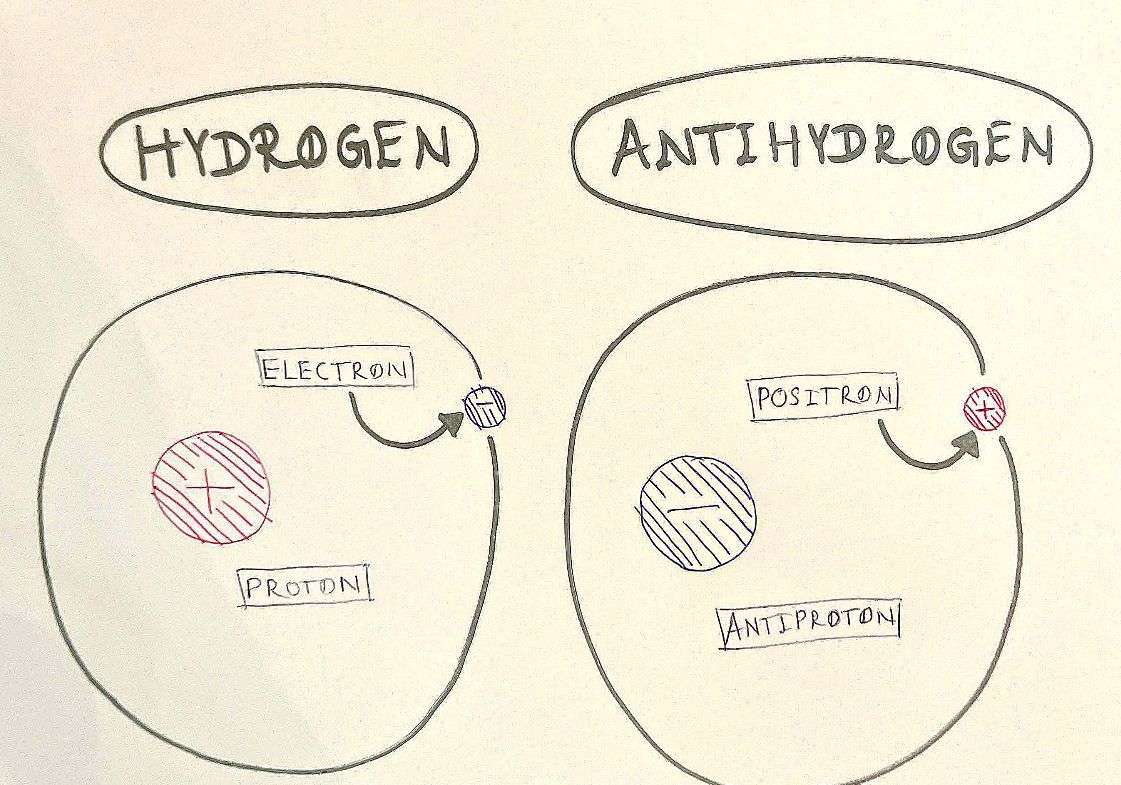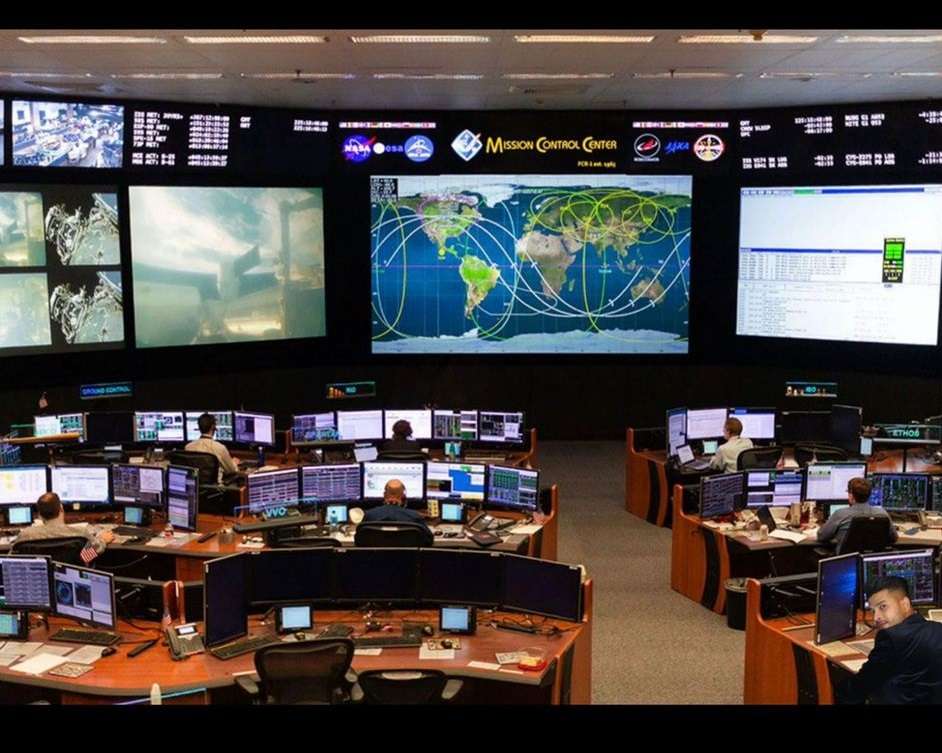Is antimatter real science or science fiction?
From the physicists’ point of view, what is strange about antimatter is that we don’t see more of it. When we collide high-energy particles in accelerators, their energy is converted into equal amounts of matter and antimatter particles (recall that according to Einstein’s famous formula, the energy (E) it takes to create matter and antimatter of total mass (m) is E=mc^2). Antimatter is a material composed of so-called antiparticles. It is believed that every particle we know of has an antimatter companion that is virtually identical to itself, but with the opposite charge. For example, an electron has a negative charge. But its antiparticle, called a positron, has the same mass but a positive charge. When a particle and its antiparticle meet, they annihilate each other – disappearing in a burst of light.

For example, you can see matter and antimatter particles created in the bubble chamber photo on the left. The photo shows many bubble tracks generated by charged particles passing through superheated liquid. Due to the magnetic field applied to the chamber, positive particles curl to the right and negative particles curl to the left. The two curled tracks highlighted in pink show an electron-positron pair created by the collision of a gamma ray photon (a highly energetic particle of light) with an atom in the chamber, in a process called pair production.
Anti-particles and antimatter may sound like the stuff of science fiction, but for particle physicists it’s something they work with every day, just as a carpenter works with nails. After decades of particle physics experiments, we now know that every type of particle has a corresponding antimatter particle, called an anti-particle. A particle and its anti-particle are identical in almost every way – they have the same mass, for example – but they have opposite charges. We have even been able to combine positrons with antiprotons to make antihydrogen “antiatoms”.
This is one of the big mysteries of physics as it clashes with some very fundamental assumptions and laws that we believe govern our universe.
At the beginning of time, an equal amount of matter and antimatter should have been created, and at some point, these particles should have met again and annihilation should have occurred. The only thing that should have been left is light. Fortunately, however, that didn’t happen and we are here.
However, this means that at the moment, we are only aware of matter in our universe – there is no sign of any antimatter available anywhere. That brings up a very fundamental question – why is that the case? Why is the universe not symmetric? Why has there been this shift towards the matter universe?
There are a number of different ways to produce antimatter. One way is to use radioactive isotopes that occur in nature. If you have an unstable isotope that decays, it might also emit antiparticles such as positrons. This is an effect which is actually used in clinical practice – for example, when doctors inject radioactive isotopes into patients. As the isotope decays, it emits a particle and an antiparticle, which can be used for positron emission tomography (PET). This can be used to image, for example, cancer cells in the body of a patient.
Producing antimatter for fundamental science studies is a little more complicated. We use one of the best known physics equations: Einstein’s E = mc2. This states that as long as you bring enough energy to a single point in space, you can create (anti)matter. The equation doesn’t say anything about what type of matter is created, but when you bring a lot of energy to one point, you will create antimatter particles as well as matter.
What Does Antimatter Look Like?
When you see antimatter depicted in science fiction movies, it’s usually some weird glowing gas in a special containment unit. Real antimatter looks just like regular matter. Anti-water, for example, would still be H2O and would have the same properties of water when reacting with other antimatter. The difference is that antimatter reacts with regular matter, so you do not encounter large amounts of antimatter in the natural world. If you somehow had a bucket of anti-water and threw it into the regular ocean, it would produce an explosion much like that of a nuclear device. Real antimatter exists on a small scale in the world around us, reacts, and is gone.
What would an antimatter universe look like?
The basic difference between matter and antimatter is that they have opposite charges. A proton has a positive charge, while an antiproton a negative one. Positively charged positrons are the antimatter version of negatively charged electrons. What’s interesting is that the signs of electric charge are a fluke of history. We could have assigned a positive charge to electrons and a negative one to protons. There’s nothing special about choosing one or the other. So you might think that an antimatter universe would look exactly like our regular one. But matter and antimatter have subtle differences.
One of the main differences has to do with neutrinos. Neutrinos don’t have any charge, so if the sign of charge were the only difference between matter and antimatter, “antimatter” neutrinos would be identical to “matter” neutrinos. But it turns out they are slightly different. Neutrinos have a property called helicity, which describes whether they spin to the left or the right as they travel through space. Matter neutrinos have left-handed helicity, while antimatter one have a right-handed helicity.
Where did all the antimatter go?
Based on numerous astronomical observations and the results of particle physics and nuclear physics experiments, we deduce that all the matter in the universe today is only about a billionth of the amount of matter that existed during the very early universe. As the universe expanded and cooled, almost every matter particle collided with an antimatter particle, and the two turned into two photons – gamma ray particles – in a process called annihilation, the opposite of pair production. But roughly a billionth of the matter particles survived, and it is those particles that now make the galaxies, stars, planets, and all living things on Earth, including our own bodies.

But suppose there was an antimatter universe that had lots of anti-hydrogen and anti-helium after its big bang, just as our early universe had lots of hydrogen and helium. It would seem reasonable that these could fuse to heavier antimatter elements in the cores of antimatter stars, and this could produce antimatter planets and perhaps even antimatter life. What would these creatures see when they look up into their night sky?
In this case we know it would look much like our own night sky. Recently we’ve been able to produce anti-hydrogen, and we have looked at the type of light it produces. We found that anti-hydrogen produces the same kind of light as regular hydrogen. So an antimatter Sun would emit the same light as our Sun. Light would reflect off an antimatter moon just as it does our Moon, and our antimatter cousins would see a sky filled with stars, nebulae and planets, just like we do.
Of course all of this is based upon the assumption that antimatter would collapse under gravity to form stars in the first place.
We think that should be the case, but what if antimatter also had anti-mass? What if anti-atoms gravitationally repelled each other?
In that case, an antimatter universe would never form stars or galaxies. Our antimatter universe would simply be filled with traces of anti-hydrogen and anti-helium, and nothing would ever look up at the cosmic sky. While we think antimatter has regular mass, we haven’t created enough of it in the lab to test the idea. For now we can’t be sure.
So it is quite possible that an antimatter universe would look nearly identical to our own. But it could be that an antimatter universe would be nothing but cold gas. It’s even possible that the radioactive decay of antimatter is so different from that of matter, that an antimatter universe can’t even exist.
Is there any difference between antimatter, dark matter, dark energy, and degenerate matter?
Yes. Although the names sound vague and almost fictional, the types of matter called antimatter, dark matter, dark energy, and degenerate matter are all different, specific entities that really exist in our universe.
Antimatter is just regular matter with a few properties flipped, such as the electric charge. For example, the antimatter version of an electron is a positron. They both have the same mass, but have opposite electric charge. Antimatter is not as exotic as science fiction makes it out to be. For starters, antimatter has regular mass and accelerates in response to forces just like regular matter. Also, antimatter is gravitationally attracted to other forms of matter just like regular matter. For every particle that exists, there is an antimatter counterpart (some particles such as photons are their own anti-particles). What makes antimatter unique is that when antimatter comes in contact with its regular matter counterpart, they mutually destroy each other and all of their mass is converted to energy. This matter-antimatter mutual annihilation has been observed many times and is a well-established principle. In fact, medical PET scans routinely use annihilation events in order to form images of patients. Antimatter is therefore only distinct from regular matter in that it annihilates when meeting regular matter. For instance, a proton and a positron are somewhat similar. They both have regular mass. They both have a positive electric charge of the same strength. They both have a quantum spin of one half. But when a proton meets an electron, it forms a stable hydrogen atom. When a positron meets an electron, they destroy each other. The key difference is that a positron is antimatter and a proton is not.
Antimatter is very rare in our universe compared to regular matter, but there are small amounts of antimatter all over the place in the natural world, including inside your body. Antimatter is created by many types of radioactive decay, such as by the decay of potassium-40. When you eat a banana, you are eating trace amounts of antimatter-producing atoms. The amount is so small, that it does not really affect your health. But it is still there.
Why doesn’t antimatter build up in your body?
The key is that our universe is mostly made of regular matter, so antimatter cannot stick around for very long. Very soon after antimatter is created, it bumps into regular matter and gets destroyed again. Antimatter is also produced by lightning and cosmic rays. It is well understood by physicists, and is predicted by standard particle physics theories.
Dark matter is matter that does not interact electromagnetically, and therefore cannot be seen using light. At the same time, dark matter does interact gravitationally and can therefore be “seen” through its gravitational effect on other matter. It is common throughout the universe and helps shape galaxies. In fact, recent estimates put dark matter as five times more common than regular matter in our universe. But because dark matter does not interact electromagnetically, we can’t touch it, see it, or manipulate it using conventional means. You could, in principle, manipulate dark matter using gravitational forces. The problem is that the gravitational force is so weak that you need planet-sized masses in order to gravitationally manipulate human-sized objects. There remains much unknown about dark matter since it is so hard to detect and manipulate. Dark matter is not predicted or explained by standard particle physics theories but is a crucial part of the Big Bang model.
Dark energy is an energy on the universal scale that is pushing apart galaxies and causing the universe to expand at an increasing rate. Like dark matter, dark energy is poorly understood and is not directly detectable using conventional means. Several lines of evidence make it clear that our universe is expanding. Not only that, our universe is expanding at an increasing rate. Dark energy is the name of the poorly understood mechanism that drives this accelerating expansion. While dark matter tends to bring matter together, dark energy tends to push matter apart. Dark energy is weak and mostly operates only on the intergalactic scale where gravitational attraction of dark matter and regular matter is negligible. Dark energy is thought to be spread thinly but evenly throughout the entire universe. Dark energy is also not predicted or explained by standard particle physics theories but is included in modern versions of the Big Bang model. Dark energy may have a connection with the vacuum energy predicted by particle physics, but the connection is currently unclear.
Degenerate matter is regular matter that has been compressed until the atoms break down and the particles lock into a giant mass. Degenerate matter acts somewhat like a gas in that the particles are not bound to each other, and somewhat like a solid in that the particles are packed so closely that they cannot move much. A white dwarf star is mostly composed of electrons compressed into a state of degenerate matter. A neutron star is mostly composed of degenerate neutrons. Further compression of a neutron star may transform it to a quark star, which is a star composed of quarks in a degenerate state. But not enough is known about quarks to determine at present whether quark stars really exist or are even possible. These concepts are summarised in the list below.
Regular Matter
Examples: electron, proton, neutron
Main Role: forms atoms, molecules, objects, planets, etc.
Reflects Light?: yes
Antimatter
Examples: positron, antiproton
Main Role: annihilates regular matter
Reflects Light?: yes
Dark Matter
Examples: unknown
Main Role: adds mass to galaxies
Reflects Light?: no
Dark Energy
Examples: unknown
Main Role: drives cosmic expansion
Reflects Light?: no
Degenerate Matter
Examples: neutron star
Main Role: forms dense stars
Reflects Light?: yes
In terms of the scientific knowledge, it is very disturbing that we don’t know why we are here. Why is there this matter universe? And why is our very fundamental understanding of the universe wrong at the moment? It is something we need to address.
Previously, nobody had ever measured whether an antiparticle in the gravitational field of the earth falls down or goes up. We still do not know all of the differences between matter and antimatter. We have no idea experimentally about some of the most fundamental aspect of our universe.





























